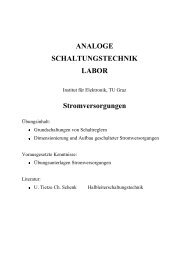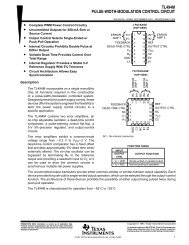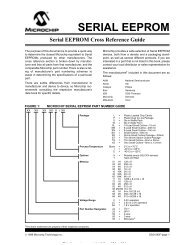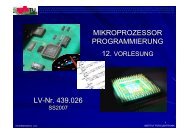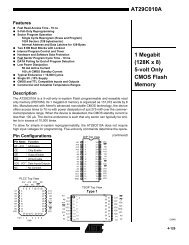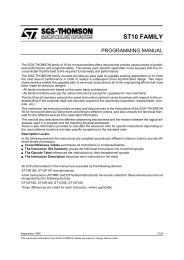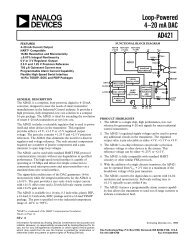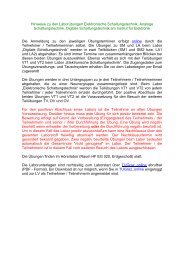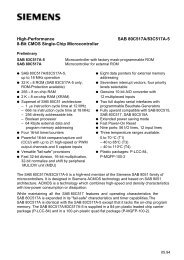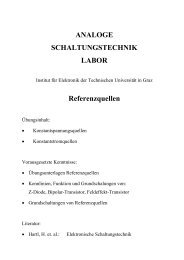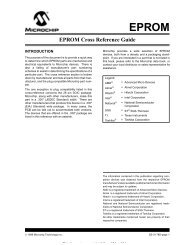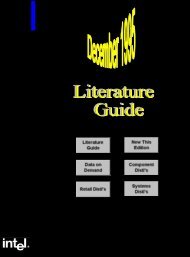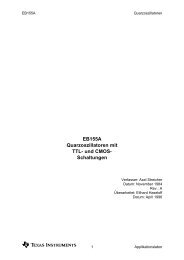AN61-1 Application Note 61 August 1994 Practical Circuitry for ...
AN61-1 Application Note 61 August 1994 Practical Circuitry for ...
AN61-1 Application Note 61 August 1994 Practical Circuitry for ...
You also want an ePaper? Increase the reach of your titles
YUMPU automatically turns print PDFs into web optimized ePapers that Google loves.
<strong>Application</strong> <strong>Note</strong> <strong>61</strong>stay there. When A1’s output is low the LTC1043’s internaloscillator sees C2 and will begin oscillation if A1 remainslow long enough. This oscillation causes charge pumpingaction via the LTC1043-C1-A1 summing junction pathuntil normal operation commences. During normal operationA1 is never low long enough <strong>for</strong> oscillation to occur,and controls the LTC1043 switch states via D1.To calibrate this circuit apply 7mV and select the 1.6M(nominal) value <strong>for</strong> 10Hz out. Then apply 2.000V and setthe 10k trim <strong>for</strong> exactly 3kHz output. Pertinent specificationsinclude linearity of 0.05%, power supply rejection of0.04%/V, temperature coefficient of 75ppm/°C of scaleand supply current of about 200µA. The power supply mayvary from 2.6V to 4.0V with no degradation of thesespecifications. If degraded temperature coefficients areacceptable, the film resistor specified may be replaced bya standard 1% film resistor. The type called out has atemperature characteristic that opposes C1’s – 120ppm/°C drift, resulting in the low overall circuit drift noted.Broadband Random Noise GeneratorFilter, audio, and RF-communications testing often requirea random noise source. 10 Figure 33’s circuit providesan RMS-amplitude regulated noise source withselectable bandwidth. RMS output is 300mV with a 1kHzto 5MHz bandwidth, selectable in decade ranges.Noise source D1 is AC coupled to A2, which provides abroadband gain of 100. A2’s output feeds a gain controlstage via a simple, selectable lowpass filter. The filter’soutput is applied to A3, an LT1228 operational transcon-<strong>Note</strong> 10: See Appendix B, “Symmetrical White Gaussian Noise,” guestwritten by Ben Hessen-Schmidt of Noise Com, Inc. <strong>for</strong> tutorial on noise.0.1(1kHz)15V16k1µFD1NC2011k+–A2LT122<strong>61</strong>.6k0.01(10kHz)0.001(100kHz)1k1k100pF(1MHz)10ΩNC(5MHz)+ A3LT1228SET–3k0.1µF910Ω+–15VA4LT1228CFA–15V510ΩOUTPUT1µFNON POLAR15V10Ω22µF22µFA5LT1006–+10k+–0.5µF–+10k–15VNC 201 = NOISE COM CORP.NOISE COM = (201) 2<strong>61</strong>-87971M1N4148THERMALLYCOUPLED4.7kLT10041.2V<strong>AN<strong>61</strong></strong> F33–15VFigure 33. Broadband Random Noise Generator Uses Gain Control Loop to Enhance Noise Spectrum Amplitude Uni<strong>for</strong>mity<strong>AN<strong>61</strong></strong>-24



